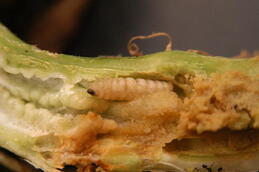Squash Vine Borer

The adult of this insect is a clear-winged moth that resembles a wasp. The forewings are a dark metallic green but the rear wings are clear. The abdomen is orange with black spots. The larva is cream-colored and rather wrinkled. Adults emerge in the spring and lay eggs on or near susceptible plants. Larva bore into the plant and feed for about a month as they move toward the base. Mature larva will exit the plant, burrow into the soil and pupate where they remain until the next year. Each plant can have numerous borers. If you suspect squash vine borer, split the stem of a collapsed plant near where it enters the ground. Infested plants will be hollowed out and mushy and may contain borers. Unfortunately, there isn’t much you can do at this late stage. Control measures should center on prevention.
Suggested preventative controls would include crushing the dull red eggs before they hatch, excavating larvae from stems before they cause much damage or using insecticide applications. Applications should begin when the vines begin to run (too late for that) and reapplied every seven to 10 days for three to five weeks. Direct the spray at the crown of the plant and the base of runners. Chemicals used for borer control in gardens are permethrin (Bug-No-More Yard & Garden Insect Spray; Eight Vegetable, Fruit & Flower Concentrate; Lawn, Garden, Pet and Livestock Insect Control; Lawn & Garden Insect Killer), bifenthrin (Hi-Yield Bug Blaster II, Bug-B-Gon Max Garden Insect Killer) or carbaryl (Sevin), applied as sprays or dusts. Continue on a 7 to 10 day reapplication schedule for 3 to 5 weeks. If plants wilt, look for the presence of holes and ooze. However, in extreme heat, these plants will wilt in the afternoon even if undamaged by this insect.



Leave a Reply
You must be logged in to post a comment.